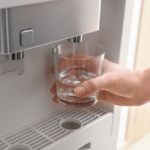What’s the deal with Disinfection ByProducts?
This blog reviews the most common disinfection byproducts (DBP), what they are, how they get into our water, and what risks they pose to our health. Most importantly, we review how you can avoid exposure to these carcinogens and how to improve your home’s water for you and your family.
Because public water supplies may contain a variety of viruses, bacteria, and other microorganisms, the Environmental Protection Agency (EPA) requires public water supply operators to add disinfectants such as chlorine to their water. According to the Centers for Disease Control and Prevention (CDC), chlorine is the chemical most commonly used to disinfect water today, and it protects consumers from gastric symptoms such as nausea, vomiting and diarrhea that may occur from microorganisms. Its history as a water disinfectant began as early as 1850 when it was used in London’s water supply during a cholera epidemic, however it has been widely used since the early 1900’s.
There are drawbacks to disinfectants, however, in that they may create byproducts that are carcinogenic. DBPs form when a disinfectant such as chlorine interacts and reacts naturally with an organic substance such as decaying leaves. Recent research has raised many safety concerns related to the effects of DBPs and many questions are being raised about how advisable it is to continue using chlorine as a water disinfectant.
You can be exposed to DBPs in water in three ways.
Through ingestion
On average, individuals consume slightly less than half of their daily water from their home faucets (1.8 cups). Tap water can contain DBPs. Some people claim they can taste the difference when disinfection byproducts are present, but many people continue drinking the contaminated water regardless.
Through skin and lungs
Disinfection byproducts are absorbed through the skin and the lungs while bathing, showering or swimming in a public pool. The average person uses 20 gallons in a 10-minute shower and 36 gallons in a full bathtub. The longer the shower or bath, the greater the exposure will be.
While experts have identified more than 600 disinfection byproducts, only 11 are currently being regulated according to the Water Research Foundation. The World Health Organization (WHO) has developed guideline values for a variety of contaminants in drinking water. Unfortunately, there is a distinction between standards and guidelines, and the WHO has recommended safe limits on DBPs, they cannot make any regulatory mandates.
The most commonly found DBPs are trihalomethanes, haloacetic acids, bromate, chlorite and chlorate – below we describe each in more detail.
Trihalomethanes
Chemist J. J. Rook discovered these in 1974 and soon thereafter the National Cancer Institute (NCI) identified them as carcinogens for humans. In 1979 the EPA began regulating trihalomethane levels in drinking water. The four trihalomethanes commonly found in chlorinated drinking water are:
Trichloromethane (chloroform)
Bromodichloromethane (BDCM)
Dibromochloromethane (DBCM)
Tribromomethane (bromoform)
The National Institutes of Health studies have linked drinking water with trihalomethanes to colorectal and bladder cancer in humans. The state of New Hampshire reports that small increases in the incidence of bladder, colon and rectal cancers have been associated with the presence of chloroform in drinking water. The state further warns that chronic oral exposure to chloroform at high doses can harm your heart, liver, kidneys and central nervous system. The EPA studied trihalomethanes specifically in regards to their impact on liver and colon cancers, and found that exposure enhanced cell proliferation, induced toxicity and caused hypomethylated C-MYC proto oncogene in humans – none of which is good.
Other scientific literature reports linkage between DBPs and birth defects, fetal developmental delays and “adverse developmental or reproductive effects in humans.” Some studies indicate a link between high levels of trihalomethanes in drinking water and early-term miscarriages.
Haloacetic acids
There are five primary varieties of haloacetic acids: chloroacetic, trichloroacetic, bromoacetic, dichloroacetic and dibromoacetic acids. Between 1998 and 2002 the EPA started to require monitoring of haloacetic acids in tap water throughout the country’s water distribution system. Between 2012 and 2016, the EPA tightened regulations on haloacetic acid levels.
Exposure to haloacetic acids, even in small doses, can irritate your skin and eyes. High exposure can cause skin and eye tissue damage. One study reported testicular damage and other reproductive system problems in rats after a single dose of dibromoacetic acid or multiple doses of dichloroacetic acid.
Bromates
Bromates form when naturally occurring bromides found in source water interact with various disinfectants. For example, when ozone (another disinfectant) reacts with bromide ions, bromates will form in the water. They can also form as a byproduct of bromate hypochlorite being oxidized by bright sunlight (for example in uncovered drinking water reservoirs).
According to the New York State Department of Health, adults who drink approximately two quarts of bromate-affected water daily would only increase their risk of cancer by two in ten thousand. However, it also warns women of childbearing age and children may experience increased rates of cancer related to long-term exposure to bromates in drinking water. Ingesting large amounts of bromates can create symptoms similar to those that disinfectants added to public water seek to reduce, such as vomiting, diarrhea, abdominal pain, nausea, kidney problems, nervous system issues and hearing loss. There are some concerns people with preexisting kidney conditions may be more susceptible to the side effects of bromates.
Chlorites and chlorates
These DBPs occur when chlorine dioxide is used to disinfect and control the odor or taste of drinking water. Chlorine dioxide is also commonly used to remove iron and manganese as well as colors from the water.
While the level of chlorites and chlorates in drinking water are not currently mandated in the US, there is strong speculation that the EPA’s next determination will include new regulations. The Canadian government uses a chlorate guideline of 1 mg/liter, and the WHO suggests a maximum of 0.7 mg/liter.
Summary
With more than 600 DBPs identified, and many believed to be unidentified, it is very difficult to determine their long-term risks to public health. However, long-term exposure to some known DBPs is believed to increase risks for a variety of negative health consequences.
You would think if so many government agencies around the world are aware of the potential risks of DBPs they would simply stop disinfecting the water with chlorine, right? Some water companies have started using chloramine for disinfecting drinking water because it is thought to create fewer DBPs than chlorine. However, since much of what may be created by chloramines is unknown, chlorine remains the dominant disinfectant used in water companies in the US.
The crucial point is that DBP’s are present at some level in every public water system in the country. One EPA study concluded “the carcinogenic activity of even a binary mixture of chemical carcinogens is difficult to predict.” Since we can’t quantify the risks, it is best to seek solutions to eliminate the risks.
As you’ve learned in this blog, it isn’t just the water you drink that can have an adverse effect on your health. It is also the water you use from your faucet for cooking, making tea, showering, washing your hands and bathing that pose potential issues.
One of the most important things you can do to reduce your family’s exposure to DBPs in your local drinking water supply is to invest in a high-quality water filtration system for your home. Filtering your water will eliminate DBPs from every tap in your home.
A few key takeaway points about disinfection byproducts in your drinking water are:
There are more than 600 identified byproducts in drinking water and believed to be many more are yet to be identified.
You may be exposed to these potentially harmful byproducts by drinking water, boiling water, turning on your taps, or swimming, bathing, or washing your hands in contaminated water.
Governments around the world have been slow to act in minimizing or restricting your exposure to these potentially dangerous byproducts.
You can take steps to reduce your exposure risks of disinfection byproducts by installing a water filtration system in your home.




